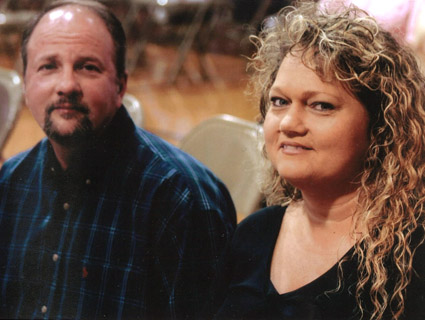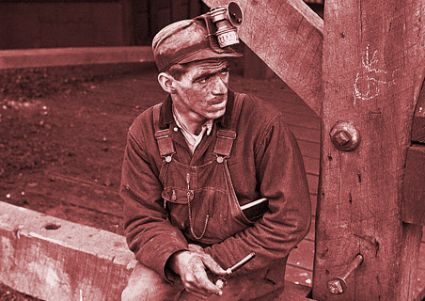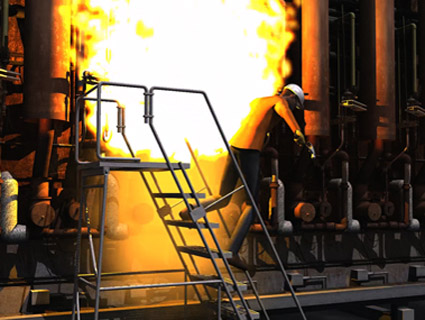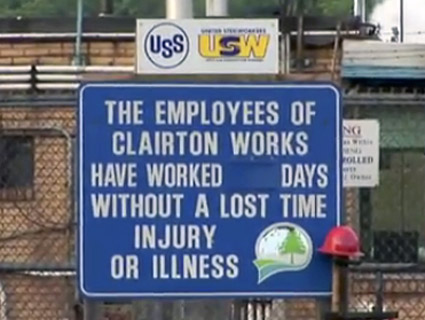
Tina Hall and her husband, L.V., in 2005. Hall was fatally burned in a workplace accident two years later.Photo courtesy of L.V. Hall
Around midnight on June 1, 2007, Tina Hall was finishing her shift in a place she loathed: the mixing room at the Toyo Automotive Parts factory in Franklin, Kentucky, where flammable chemicals were kept in open containers.
A spark ignited vapors given off by toluene, a solvent Hall was transferring from a 55-gallon drum to a hard plastic bin. A flash fire engulfed the 39-year-old team leader, causing third-degree burns over 90 percent of her body. She died 11 days later.
After investigating the accident, the Kentucky Labor Cabinet’s Department of Workplace Standards cited Toyo for 16 “serious” violations and proposed a $105,500 fine in November 2007.
“You’re disappointed because you think, That’s all they got fined?” Hall’s sister, Amy Harville, of Moulton, Alabama, said in a telephone interview. “But then I thought, at least they got 16 violations. I was thinking they’d stick, as severely as she was burned.”
The violations didn’t stick. Every one of them went away in 2008, as did the fine, after Toyo’s lawyer vowed to contest the enforcement action in court. Last month, in a move believed to be unprecedented in Kentucky, the Department of Workplace Standards reinstated all the violations because, it said, the company hadn’t made promised safety improvements.
The case was another black eye for state-run workplace health and safety programs nationwide. In all, 26 states administer their own programs under federal supervision. Several have been criticized in recent years for capitulating to lawyered-up employers, performing subpar inspections, and shutting out accident victims’ families.
Officials in Kentucky didn’t tell Harville and Hall’s husband that the Toyo violations had been dismissed. They found out in 2010 only because Ron Hayes, a fellow Alabamian who runs a nonprofit advocacy group for families of fallen workers, had taken an interest in the case and checked in regularly with the Department of Workplace Standards.
Hayes—whose son, Pat, died in a Florida grain elevator accident in 1993—lodged a formal complaint against Kentucky with the US Department of Labor’s Occupational Safety and Health Administration, which concluded in June 2011 that the state had erred.
“Deleting citations in their entirety sends a signal to employers that they need only contest to alleviate the burden of history,” OSHA’s regional administrator in Atlanta, Cindy Coe, wrote to Hayes.
In a written statement, Kentucky’s Department of Workplace Standards said it dismissed the violations after determining that “the case would not have withstood legal challenge.” Instead, the department and Toyo entered into a settlement agreement, which provided for follow-up inspections. Toyo’s alleged failure to meet the terms of that agreement led to the reinstatement of the violations last month.
The reinstatement showed that the violations never should have been dropped in the first place, Hayes said. “It’s vindication, because we said all along this was wrong,” he said.
The president of Toyo Automotive Parts did not return calls seeking comment. In a 2008 legal filing, Toyo denied responsibility for Tina Hall’s death, calling the accident “the result of unforeseeable, isolated acts undertaken by an individual employee.”
“systemic problems”
Under the Occupational Safety and Health Act of 1970, states that choose to regulate workplace health and safety must ensure that their programs are “at least as effective” as the federal one. OSHA pays up to half the cost of such programs and is supposed to keep tabs on them.
By some accounts, it hasn’t done a particularly good job. After press reports about a rash of construction worker deaths in Las Vegas, OSHA reviewed the Nevada program in 2009 and found a long list of flaws. Among them: State inspectors weren’t sufficiently trained to identify construction hazards and were discouraged by managers from issuing “willful” violations—which suggest an employer showed “plain indifference to the law” and can lead to stiff penalties—to avoid protracted court battles.
OSHA looked at the programs in the 25 other states that administer their own the following year, finding deficiencies such as uncollected penalties in North Carolina and misclassified violations in South Carolina. Kentucky, OSHA found, was taking too long to issue citations and wasn’t making complainants aware of “specific official findings.”
In 2011, the Labor Department’s inspector general reported that OSHA hadn’t found a suitable way to measure the effectiveness of state programs. In his response to the IG, OSHA chief David Michaels wrote that the agency was developing a new monitoring system that would involve, among other things, reviews of state enforcement case files.
Still, Hayes believes that “systemic problems” persist. “Oversight from federal OSHA has been lacking for the past 42 years,” he said. “There are so many different problems from state to state.”
Indeed, Hawaii’s program—described as “poor” in a 2010 OSHA report—has been severely hampered by budget and staffing cuts for the past three years. Things got so bad that state officials recently asked the federal government for help.
In its 2007 annual report, Toyo Tire & Rubber Co., a Japanese conglomerate that makes tires, auto parts and chemicals in plants around the world, lists what it calls “The Five Commitments.”
“We make safety our highest priority in the provision of products and services,” reads Commitment No. 2.
Tina Hall thought otherwise, according to her husband. At the time of the accident in June 2007, she was trying to transfer out of the Franklin plant’s adhesive department because the job required her to spend time in the mixing room, where toxic and flammable chemicals were stored.
“She talked about how bad the fumes were in that room,” said L.V. Hall, who lives in Bremen, Alabama. “She said something about the disposal of chemicals—they weren’t doing it right. I’d been wanting her to get out of that mess.”
Tina Hall and other team leaders would go into the mixing room to fill plastic bins, known as totes, with solvents such as toluene. They’d clean gummed-up machine fixtures in the totes. Team leaders also would fill five-gallon buckets with solvents and carry them to adhesive machines on the factory floor. The solvents were used to take residue off the machines.
Kentucky’s Department of Workplace Standards would later cite Toyo for obstructing exit routes in the mixing room, not keeping flammable liquids in covered containers when they weren’t being used, failing to control vapors and having inadequate fire-protection equipment.
On the night of the accident, Tina Hall was cleaning fixtures by herself when a spark, likely caused by static electricity, ignited toluene vapors and set off an explosion in a 55-gallon drum of methyl isobutyl ketone, another solvent.
Then a General Motors assembly line worker, L.V. Hall was awakened at home in Auburn, Kentucky, by a call from a Toyo team leader around midnight. His wife, on fire, had managed to get outside and roll on the ground. “How she got outside I don’t know,” Hall said. “It was like an obstacle course to find the exit door.”
Tina Hall was taken to a local hospital, then to Vanderbilt University Medical Center in Nashville, about 45 minutes away. L.V. had a brief talk with her before the doctors put her into a coma to shield her from the pain. “She said, ‘I did everything the way I was supposed to do it,’ ” Hall said. His wife drifted off and never regained consciousness. She died on June 12, 2007.
A “travesty of justice”
Not long afterward Tina Hall’s younger sister, Amy Harville, was directed to Ron Hayes by an acquaintance. Burly, white-bearded and tenacious, Hayes lives in Fairhope, Ala., and runs the FIGHT Project, which helps families navigate the bureaucracy of workplace fatality investigations. Hayes counseled Harville and L.V. Hall as the state’s inquiry into the Toyo accident progressed.
When the Department of Workplace Standards issued 16 serious violations against the company in November 2007, “I was OK with it,” L.V. Hall said. “I didn’t realize that once that’s done, these attorneys can get in there and just do away with it.”
Documents obtained by the Center for Public Integrity under the Freedom of Information Act show how Toyo’s lawyer, Mark Dreux of Arent Fox in Washington, D.C., fought the state of Kentucky from the beginning. Dreux declined to comment on the case.
In March 2008, the state offered to reduce the penalty from $105,500 to $74,000. Dreux refused. In June 2008, the state proposed a further reduction, to $15,000, for three violations. Dreux said no. In November 2008, Dreux got what he wanted: No violations and no fine.
It was Hayes who first learned, in July 2010, that all the violations had been deleted. He alerted Harville.
“I was devastated,” she said. “It takes you back all over again, like Tina was killed for the second time.”
She called L.V. Hall, who reacted similarly. “I was just shaking I was so upset,” he said. He called the Department of Workplace Standards and finally reached “the lady attorney who was over the case. I basically told her, ‘I cannot believe y’all dropped every one of those citations.’ She said, ‘Well, Mr. Hall, I am an attorney and there was not enough evidence.’ “
Hayes knew what to do. He filed a CASPA—Complaint About State Program Administration—with OSHA’s Atlanta regional office, calling Kentucky’s dismissal of the citations a “travesty of justice.”
After an investigation, regional administrator Cindy Coe, in essence, agreed, writing in June of last year that “the violations were well documented and legally sufficient and there was no definitive evidence in the file that indicated that they could not be supported.” Deleting all the citations, Coe wrote, erases an employer’s safety history and deprives regulators of critical information should subsequent enforcement actions commence.
“It also signals to compliance staff that their efforts are for no good end, if the point is to drop everything at the threat of going to court,” the administrator wrote. “It further signals to employees in the workplace that there is no entity on their side.”
In his response to Coe, the commissioner of the Kentucky Labor Cabinet, Michael Dixon, wrote that the state “does not retreat from litigation” but didn’t believe it could defend the case before the Kentucky Occupational Safety and Health Review Commission, an appeal body.
In May, a state inspector returned to the Toyo plant in Franklin to see if the company had done all the things it said it would do after Tina Hall’s death—making sure supervisors were trained in the correct way to clean fixtures, for example. It hadn’t.
In a July 5 letter, Susan Draper, then director of the Kentucky Labor Cabinet’s Division of Occupational Safety and Health Compliance, notified Ronald Wayans, president of Toyo Automotive Parts (USA), that the 16 original citations had been reinstated, as had the proposed $105,500 penalty. The Tina Hall case had come full circle.
Sometime in the next few weeks, Amy Harville, L.V. Hall and Hall’s lawyers expect to meet with Dixon and Toyo counsel. They expect to learn whether Toyo intends to accept its punishment or continue fighting.
“When somebody gets killed in one of these workplaces, it shouldn’t be this way,” L.V. Hall said. “I had Ron Hayes on my side and he knew what to do. Most people don’t have Ron. These citations never would have been brought back without him.”
The Center for Public Integrity is a nonprofit, independent investigative news outlet. This story is part of its Hard Labor series.











